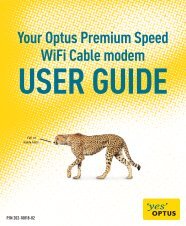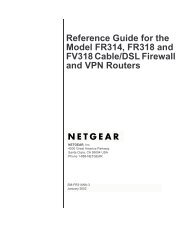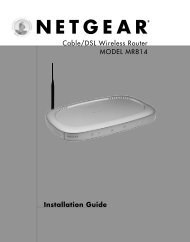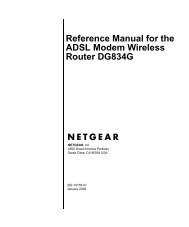Reference Manual for the Model CG814M Wireless Cable ... - netgear
Reference Manual for the Model CG814M Wireless Cable ... - netgear
Reference Manual for the Model CG814M Wireless Cable ... - netgear
Create successful ePaper yourself
Turn your PDF publications into a flip-book with our unique Google optimized e-Paper software.
<strong>Reference</strong> <strong>Manual</strong> <strong>for</strong> <strong>the</strong> <strong>Model</strong> <strong>CG814M</strong> <strong>Wireless</strong> <strong>Cable</strong> Modem Gateway<br />
<strong>Wireless</strong> Networking<br />
The <strong>CG814M</strong> Gateway con<strong>for</strong>ms to <strong>the</strong> Institute of Electrical and Electronics Engineers (IEEE)<br />
802.11b standard <strong>for</strong> wireless LANs (WLANs). On an 802.11b wireless link, data is encoded using<br />
direct-sequence spread-spectrum (DSSS) technology and is transmitted in <strong>the</strong> unlicensed radio<br />
spectrum at 2.5GHz. The maximum data rate <strong>for</strong> <strong>the</strong> wireless link is 11 Mbps, but it will<br />
automatically back down from 11 Mbps to 5.5, 2, and 1 Mbps when <strong>the</strong> radio signal is weak or<br />
when interference is detected.<br />
The 802.11b standard is also called <strong>Wireless</strong> E<strong>the</strong>rnet or Wi-Fi by <strong>the</strong> <strong>Wireless</strong> E<strong>the</strong>rnet<br />
Compatibility Alliance (WECA, see http://www.wi-fi.net), an industry standard group promoting<br />
interoperability among 802.11b devices.<br />
<strong>Wireless</strong> Network Configuration<br />
The 802.11b standard offers two methods <strong>for</strong> configuring a wireless network - ad hoc and<br />
infrastructure.<br />
Ad-hoc Mode (Peer-to-Peer Workgroup)<br />
In an ad hoc network, computers are brought toge<strong>the</strong>r as needed; thus, <strong>the</strong>re is no structure or fixed<br />
points to <strong>the</strong> network - each node can generally communicate with any o<strong>the</strong>r node. There is no<br />
Access Point involved in this configuration. This mode enables you to quickly set up a small<br />
wireless workgroup and allows workgroup members to exchange data or share printers as<br />
supported by Microsoft Networking in <strong>the</strong> various Windows operating systems. Some vendors<br />
also refer to ad hoc networking as Peer-to-Peer group networking.<br />
In this configuration, network packets are directly sent and received by <strong>the</strong> intended transmitting<br />
and receiving stations. As long as <strong>the</strong> stations are within range of one ano<strong>the</strong>r, this is <strong>the</strong> easiest<br />
and least expensive way to set up a wireless network.<br />
Infrastructure Mode<br />
With a wireless Access Point, you can operate <strong>the</strong> wireless LAN in <strong>the</strong> infrastructure mode. This<br />
mode provides wireless connectivity to multiple wireless network devices within a fixed range or<br />
area of coverage, interacting with wireless nodes via an antenna.<br />
B-12 Networks, Routing, and Firewall Basics
















